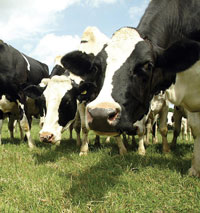Top milk yields from grass possible, farm walk hears

Maximising milk from grass can be tricky when also aiming for high yields, but as a Wiltshire family is proving, with good grass and cow management alongside good teamwork, it can be achieved.
The key to successfully grazing high yielders was ensuring cows had an incentive to graze, David Homer told visitors to an RABDF, BGS and DairyCo farm walk at Chisbury Lane Farm, Chisbury.
“Cows should never be hungry, but they should go out to grass with an edge on appetite,” said Mr Homer. “Cows always go to ‘a fresh bite’. We are not strip grazing here. This guarantees they are keen to graze.”
Buffer feeding cows for a couple of hours before milking had also been an effective way of increasing grass intakes. “After milking, cows naturally have the instinct to eat and drink. By sending them straight out to grass we are simply taking advantage of this.”
The aim had always been to get 7kg DM a cow a day from grazing, said farm consultant Douglas Green of Green and Kelly Consultants. “When cows were set stocked four years ago, they simply weren’t achieving this figure.”
Although arguably it would have been easier to move to 365 day housing, said Mr Homer, this was not an option. “Where’s the challenge in that?” he asked. “Grazing lazy, concentrate-fed Holsteins is always interesting, but it is possible.”
The key was to treat grass as any other component of the ration and include it in diet formulation, said Piers Badnell, DairyCo extension officer. “Grass is a cheap feed, but only when managed well.”
Discussions with Mr Badnell, really bought home the importance of grassland management to eldest son, Chris Homer. “When Piers held up the grass plate meter next to the mixer wagon, it was obvious they both provide valuable data. This made us appreciate a grass plate meter is as important a tool as the mixer wagon.
“We use the wagon every day to monitor exactly what cows are eating, yet grass intakes are often just an estimate.” From this point on, the Homers began using a grass plate meter twice a week to monitor and plan grass rotation.
The key to getting the most out of grass was optimising quality and use, Mr Badnell said. “Nationally, everyone should be aiming to achieve 80% grass use. In reality, I think this figure is more likely 40%.
“To get optimum growth and efficiency, grass should be grazed at the three-leaf stage and grazed down to 5cm or a residual of 1500kg/ha DM,” said Mr Badnell. “Rotational grazing is the best way to ensure rest and recovery and maintain grass quality.”
Grazing in such a way came with a number of benefits, said David Homer. “Ultimately, there is a significant economic benefit. The winter diet costs us £2.90 a cow a day, now we are looking at feed costs of £2.10 a cow a day.” Milk from forage is similar to before, but there has been a displacement towards grazed grass.
Mr Homer stressed these results were only achievable through efficient nutrient management and maintaining grass quality throughout. “If you just opened the gate and let them out you would see a major yield drop.”
With increasing grass use efficiency in mind, the Homers had now installed a segging gate. “This will allow us to graze as one group in the morning and then use the gate after milking to separate out the lows and graze them 24 hours a day.”
